|
35mm 'Full Frame'
Photography |
June 2010
With the
advent of digital, in 2006, I bought a Canon 5D MK1 Digital Single Lens Reflex
Camera a Canon 24mm MK1 f1.4 L Lens and a Canon 50mm f1.4
Lens............later I added a Canon 100mm f2 Lens. I had spent a great
deal of time searching for a smaller digital single lens reflex camera
and smaller 'prime' lenses but the 5D was the smallest available that
had a '35mm full frame' sensor. I thoroughly enjoyed the 5D combo as it
produced exactly the same style of images that my old film cameras had
produced...........just like my film cameras, I started to take the 5D
for granted as it was not getting in the way of my photography.
Then it all
went wrong..........the idea sprung into my head that the size of my
Canon 5D kit was to large, it was heavy to carry around and the solution
surely must be smaller lenses, smaller bag and perhaps a more discreet
camera? I completely forgot that if I wanted a 35mm 'Full Frame' digital
sensor then.........yes, the camera would have to be larger. The
Internet Forums did not help, with the arguments for smaller camera
versus larger DSLRs and all the innuendos that were
included........."who wants a big camera and lens stuck in their
face"..........."you know what they say he has to show of his manliness
with a big lens".........."it has to be small and discreet on the
street" So I spent a great deal of time purchasing 'alternative' crop
sensor camera solutions and using the 5D less and less. I like the image
style and just as important, the photographic control that I get with
35mm full frame which to a certain extent outweighs (if you pardon the
pun) the crop series of cameras. However, it has to be said, that
there is a place for my 'latest' smaller, lighter and less expensive
camera with a crop digital sensor, the Panasonic GF1, especially as I
cannot achieve a 35mm 'full frame' digital small lightweight set-up.
The only
other purchase that I had made which came anywhere near the mark for the
correct size, weight, ease of use and produced the style of image that I
enjoyed, was a secondhand Nikon FM3a 35mm 'Film' SLR Camera with AI-s
Lenses..........I had travelled full circle and back to 'Full Frame'.
I decided to compare the Canon 5D
DSLR against my Nikon FM3a for size, each with a 50mm Lens fitted.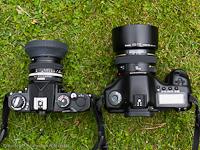 The 5D had the Canon 50mm f1.4 USM Lens with a UV filter and Canon hood,
the FM3a had a Nikon 50mm f1.4 AI-S Lens fitted with UV filter and Hama
rubber hood.
The 5D had the Canon 50mm f1.4 USM Lens with a UV filter and Canon hood,
the FM3a had a Nikon 50mm f1.4 AI-S Lens fitted with UV filter and Hama
rubber hood.
The Nikon FM3a was about the size and weight that I would like a 35mm
Digital 'Full Frame' sensor camera to be and the 50mm AI-s Lens about
the correct size and weight. When you start to look at a digital 35mm
'full frame' sensor camera like the Leica M9 and it's M Lenses, you find
that it is very similar in size to the FM3a kit.
The Canon 5D is larger, especially in body height but it is only
when it is coupled with it's larger lenses than it really 'expands' to
become a little inconvenient in size and weight. The kit itself is not
to bad but when you add the Lowepro 'Mini Mag' AW shoulder bag the
overall size becomes more apparent.
It's June
2010 and I have once again checked all the latest digital camera
releases, read the reviews; all with the sole and final solution
in mind.........a 35mm 'full frame' sensor digital camera that can
interchange 'prime' lenses and which is small and lightweight for
carrying around. The only camera that fits the bill is a Leica M9
Digital Rangefinder and Leica M lenses but at a horrendously high price.
What are my
options for reducing the size and weight of 35mm 'Full Frame' as Digital Technology currently stands:-
-
Sell
all my kit and purchase a Leica M9 + Leica M Prime Lenses?
-
Wait
until the 1st quarter of 2012 to see what the manufacturers release?
-
Continue to use the Canon 5D MK1 DSLR + Canon Prime Lenses?
I finally
decided to stick (for the meantime) with my Canon 5D Camera and it's prime
'fast' lenses. This kit was the nearest (apart from my Nikon '35mm Film'
kit) that could emulate the Leica M9 + M Lenses solution albeit it was
larger and heavier.
I decided to
use my Lowepro 'Mini Mag AW' shoulder bag to carry it all and listed the
contents as follows:-
-
Canon 5D
MK1 Digital SLR Camera + Battery + 4Gb Sandisk Memory Card
-
Spare 4Gb Sandisk
Memory Card
-
Spare
Battery
-
Canon
24mm f1.4 L Lens (Reversed Hood) + 77mm UV Filter
-
Canon
50mm f1.4 Lens (Reversed Hood) + 58mm UV Filter
-
Canon
100mm f2 Lens (Reversed Hood) + 58mm UV Filter
-
B+W 58mm
2 Stop 'Gray' Graduated Filter
-
B+W 77mm
2 Stop 'Gray' Graduated Filter
-
Jessops
Blue Cleaning Cloth
-
Blower
Bulb/Brush
-
Small
Bottle Cleaning Fluid + Felt Cloths
-
Packet
of Cotton Buds
The total weight
came to 4.2Kgs.
Kit
Overview
I have not
used my prime lenses with the Canon 5D for over two years, barring the
odd shot or two. During that time, I have mainly used my primes with the
Canon 450D DSLR as I had tried to get the overall kit as small and
lightweight as possible. Now I was back to 'Full Frame' and it was an
interesting experience to pick up the larger and heavier Canon 'Full
Frame' Camera.
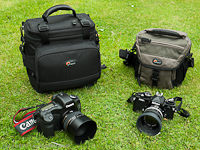
Out of interest I compared the Canon 5D with its three lenses against
the Nikon FM3a kit and the shoulder bags that were required to carry
them. There is a sizeable difference between the two but the bag of the
Canon 5D could be 'considerably reduced' in size and weight, if one lens
was removed and say the 24mm + the 50mm replaced with a Canon 35mm f1.4
L Lens.
The first day that I started to use the gear, I was fully expecting to
find that the overall weight would put a strain on my shoulder blade as
I had slung the bag strap over my right shoulder to carry it around but
this was not the case. I was pleasantly surprised........in fact the
only weight that I experienced was when the Canon 5D with the Canon 24mm
L Lens fitted was being carried by the neck strap for a prolonged period
of time and the weight bore
down on my neck and shoulders. This did not happen with the other two
lenses and the bag itself was never a weight problem, especially when I
was using the camera with a lens fitted outside the bag for taking
pictures. Usually when I have used the 5D with my Canon 24-105mm L Lens
fitted for travel photography, I have found the 'daily shooting' weight plays havoc with my arm muscles and
neck but this
did not happen with the 5D and any of my three primes fitted and in use.
My prime lenses are a great deal shorter than my 24-105 L Lens
and I think this has a bearing on the distribution of the weight to the
arms and neck not to mention the back.
You read about professionals who use the Canon 1D range of DSLR cameras
and you often wonder if a 100% viewfinder makes a great deal of
difference? Well, having used a Canon 450D DSLR camera for a long period
with my prime lenses for the street, sport, wildlife photography and a
Panasonic GF1 digital camera for casual use..........the Canon 5D which
does not have a 100% viewfinder was a dream and utterly brilliant to use
again. The Canon 1D viewfinder must be fantastic?
The three prime lenses were fast to autofocus with the Canon
5D camera. For 'hand held' wide open shots I tend to use the 'spot'
focus............using the AE to lock the overall image exposure
to my liking, spot autofocus on the part of the image I wanted in focus
and half pressing the shutter button to lock the focus and then
re-aligning the scene before fully pressing the shutter fully down to
take the shot. I tend to find that I use 'spot' focus more and more
these days, even for 'hand held' landscape shots............it must be something to
do with my aspirations to own a Leica M9 or perhaps it just makes sense?
I also like bracketing exposures in very uneven light conditions and
then selecting the best one. As a last resort, I may blend exposures
where possible. The added bonus is that all the primes can be switched
to manual focus and are very fast and easy to use.
Lowepro 'Mini Mag AW' Shoulder Bag
This is a heavier bag than most Lowepro shoulder bags but it is
waterproof and all weather protected. It has been around for a good few
years but it is seriously a 'professional' style bag with good solid
padding and protection for my gear.
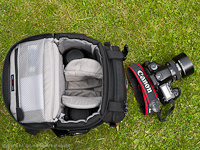 It has a waterproof cover tucked in
a special compartment and a strong carrying handle and shoulder strap.
Its built to carry a larger DSLR camera than the Canon 5D, the camera sits in the centre with the fitted
lens facing down (holster style) and a lens sits at either side of the
two partitions (camera + three lenses in all). The 'Mini Mag AW' has a
large front zip compartment for holding accessories with extra inner
pouches built into the top and inside the lid. There is a zip 'folder'
compartment on the outside on the back of the bag. The lid
has a sturdy zip and it is also double secured with two webbing belts
with click/clasps on the top. It has a waterproof cover tucked in
a special compartment and a strong carrying handle and shoulder strap.
Its built to carry a larger DSLR camera than the Canon 5D, the camera sits in the centre with the fitted
lens facing down (holster style) and a lens sits at either side of the
two partitions (camera + three lenses in all). The 'Mini Mag AW' has a
large front zip compartment for holding accessories with extra inner
pouches built into the top and inside the lid. There is a zip 'folder'
compartment on the outside on the back of the bag. The lid
has a sturdy zip and it is also double secured with two webbing belts
with click/clasps on the top.
The bag is meant to be tough with its re-enforced fittings on the
outside and thick padding on the inside. The downside, is that toughness
means extra weight and the 'Mini Mag' is heavier than most similar sized
Lowepro shoulder bags. The plus side is that I never worry about
dropping this bag with my gear in it and with the outside webbing straps
and clasps, I know it is never going to burst open and spill my gear,
even in the 'extremely' unlikely event that the lid zip failed.
Canon 100mm f2 USM Lens
This is my
favourite lens because I love it's range for pulling in distant
landscapes, portraits and it's great for a narrow depth of field at
aperture f2.........sure it would be great if it were the size of a
Leica Summicron 90mm f2 APO-M Lens but never the less it is very capable on
the Canon 5D DSLR. I find this lens a real treat to use and when fitted
to the Canon 5D DSLR, the overall weight does not drag down on my neck
and shoulders when I use the neck strap. I can carry it in my hand for
prolonged periods without any problems and its fast to autofocus,
recompose and shoot.
Some of the first shots were taken at the house and as usual my mother
and the property were the subjects. The image of my mum was my
first serious effort with the 100mm to capture a decent portrait.
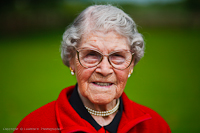 It
was taken 'hand held' outside at ISO:100, aperture f2 and shutter at
1/6400sec. The main
'spot' focus area is on my mum's nose tip. I softened the 'RAW' image in
post processing using Adobe Lightroom Version 3. I have just started to
take portraits with the Canon 5D + the 100mm f2 lens and I prefer the
softened look of the image. If I was to restore it to it's proper
sharpness the nose and the front of the glasses frame would be in my
opinion much coarser and not as nice. Its early days and hopefully my
'portrait' photography skills will improve? It
was taken 'hand held' outside at ISO:100, aperture f2 and shutter at
1/6400sec. The main
'spot' focus area is on my mum's nose tip. I softened the 'RAW' image in
post processing using Adobe Lightroom Version 3. I have just started to
take portraits with the Canon 5D + the 100mm f2 lens and I prefer the
softened look of the image. If I was to restore it to it's proper
sharpness the nose and the front of the glasses frame would be in my
opinion much coarser and not as nice. Its early days and hopefully my
'portrait' photography skills will improve?
This next
shot was taken 'hand held' in the back garden and the subject was a bird
bath on the patio.
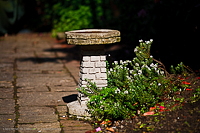 It
was taken at ISO:100, aperture f2 and shutter at 1/6400sec. The main
'spot' focus area is on the top front lip of the table. It was a sunny
day and the light was reflecting of the bird table stand. This image was
processed in LR3 with very light contrast and saturation applied. I
finally used Canon's DPP Software to sharpen the LR3 re-sized web
'plate' image. The Canon 100mm f2 lens images have so much room for
'post processing' and the colours are great. It
was taken at ISO:100, aperture f2 and shutter at 1/6400sec. The main
'spot' focus area is on the top front lip of the table. It was a sunny
day and the light was reflecting of the bird table stand. This image was
processed in LR3 with very light contrast and saturation applied. I
finally used Canon's DPP Software to sharpen the LR3 re-sized web
'plate' image. The Canon 100mm f2 lens images have so much room for
'post processing' and the colours are great.
I really like shooting the 100mm lens wide open and I am very confident
of using the 'spot' autofocus of the Canon 5D at aperture
f2........something I was never sure of with the Canon 450D DSLR.
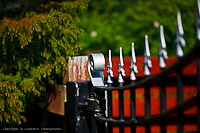 I
never feel the need to take more than one shot with the 5D. The railing
shot was taken 'hand held' with the 100mm at ISO:100, aperture f2 and
shutter at 1/6400sec. The main 'spot' focus area is on the black hinge
of the gate. The final image was processed using Lightroom Version 3,
with slightly increased contrast and saturation. Again, I used Canon's
DPP Software to bring up the sharpness of the lens on this LR3 re-sized
web 'plate' image. I
never feel the need to take more than one shot with the 5D. The railing
shot was taken 'hand held' with the 100mm at ISO:100, aperture f2 and
shutter at 1/6400sec. The main 'spot' focus area is on the black hinge
of the gate. The final image was processed using Lightroom Version 3,
with slightly increased contrast and saturation. Again, I used Canon's
DPP Software to bring up the sharpness of the lens on this LR3 re-sized
web 'plate' image.
Later in June, I went up to Peterhead in Scotland to visit my family and
to hold my new grandson for the first time. It was a great day with good
light and as I turned a corner just outside Peterhead I saw this scene
of Boddam Lighthouse on the other side of the road. I stopped the car
and captured this 'hand held' shot using the 100mm at ISO:100, aperture
f8 and shutter at 1/500sec.
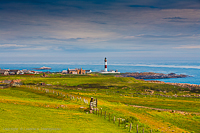 I
should have put on my '2 stop' 58mm graduated grey filter but I was late
and I was a lazy photographer. The final image was processed using
Lightroom Version 3, a 2.5 graduated 'software' grey filter was applied
to the sky area with 'overall' increased contrast and saturation. Also I
like sharper images and because LR3 has it's limitations..........I used
Canon's DPP Software to up the sharpness on this LR3 re-sized web
'plate' image. I
should have put on my '2 stop' 58mm graduated grey filter but I was late
and I was a lazy photographer. The final image was processed using
Lightroom Version 3, a 2.5 graduated 'software' grey filter was applied
to the sky area with 'overall' increased contrast and saturation. Also I
like sharper images and because LR3 has it's limitations..........I used
Canon's DPP Software to up the sharpness on this LR3 re-sized web
'plate' image.
When I arrived at Peterhead, I saw my grandson and held him for the
first time............a great feeling............the moment carried me
back some 25 years to when I held his dad. The occasion called for some
family pictures and amongst the many images I captured, I like this one
of the family together.
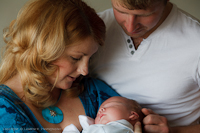 It
was taken indoors in natural light with the 100mm at ISO:200, aperture
f4 and shutter at 1/100sec. The lens is so sharp at f4, I once again had
to deliberately soften the image in LR3. The main 'spot' focus area is
on the babies nose. It
was taken indoors in natural light with the 100mm at ISO:200, aperture
f4 and shutter at 1/100sec. The lens is so sharp at f4, I once again had
to deliberately soften the image in LR3. The main 'spot' focus area is
on the babies nose.
The next
day, I went down to the harbour at Peterhead and spent an hour taking
pictures of the area and the people. It was not particularly a great day
and the sky was overcast and grey. I used all my prime lenses
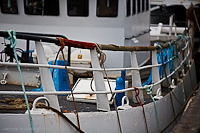 and
this is one of a boat taken with the 100mm lens at ISO:100, aperture f2
and shutter at 1/6400sec. The final image was processed using Lightroom
Version 3, with slightly increased contrast and saturation. Again, I
used Canon's DPP Software to bring up the sharpness of the lens on this
LR3 re-sized web 'plate' image. The 'spot' focus is on the front section
of the boat and I think the lens has produced a very nice narrow depth
of field effect? and
this is one of a boat taken with the 100mm lens at ISO:100, aperture f2
and shutter at 1/6400sec. The final image was processed using Lightroom
Version 3, with slightly increased contrast and saturation. Again, I
used Canon's DPP Software to bring up the sharpness of the lens on this
LR3 re-sized web 'plate' image. The 'spot' focus is on the front section
of the boat and I think the lens has produced a very nice narrow depth
of field effect?
Later I went
for a walk with the family and enjoyed pushing my grandson in his pram.
I took more pictures, in fact lots of pictures, to capture those
precious 'first' moments with the new arrival. I later tried all sorts
of post processing
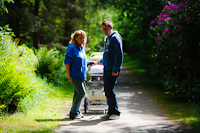 techniques
with LR3 but this image, once again was softened 'for effect' as
I felt that the original 100mm 'camera' image was a shade to harsh and
sharp. The one thing I love about the Canon 100mm f2 lens is just how
sharp it is wide open at f2 and all the way to f8. For some images I
want the sharpness and it is available in spades. When it requires a
softer approach, it is very easy to tone the sharpness down. techniques
with LR3 but this image, once again was softened 'for effect' as
I felt that the original 100mm 'camera' image was a shade to harsh and
sharp. The one thing I love about the Canon 100mm f2 lens is just how
sharp it is wide open at f2 and all the way to f8. For some images I
want the sharpness and it is available in spades. When it requires a
softer approach, it is very easy to tone the sharpness down.
Using the Canon 100mm f2 USM Lens is a lot of fun and I am looking
forward to using it with my Canon 5D 'Classic' DSLR for 'street'
photography. The narrow depth of field at f2 combined with the sharpness
and a 'very decent' bokeh makes it a cracker. It is lighter and smaller
than my Canon 24-105L lens as well as my Canon 100mm f2.8 USM lens and
only becomes more noticeable when the hood is on. The hood, what a
disaster.........it's great once it is fitted but putting it on is a
nightmare. You have to pinch the two small recesses on the front (either
side) with your thumb and finger to retract the small inner clips to
allow it to fit over the filter or lens lip then release to lock on.
Trouble is that by pressing (to heavily) the hood distorts its roundness
and will not fit on.......I have had on occasions to use both hands to
open the clips and to prevent the distortion by using the other hand to
keep the hood in a round shape. This is a small criticism and certainly
not a deal breaker...........want a very inexpensive autofocus/manual
lens that can hold court with lenses of much greater cost.........that
will be the Canon 100mm f2 USM Lens.
Canon 50mm f1.4 USM Lens
The inexpensive and very much underestimated Canon 50mm f1.4 USM Lens is
a little gem. Small, lightweight and without the hood very unobtrusive.
I find this lens a real pleasure to use and when fitted to the Canon 5D
DSLR the weight does not drag down on my neck when I use the neck strap.
The hood is a dream fit with it's 'twist on action' over the filter onto
the lens lip.
In June, I used it for shots
of Cammo Estate in Edinburgh along with the other two lenses and I found
that it's focal range, depth of field and bokeh were very pleasant.
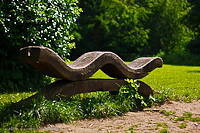 This
50mm lens is about as small as it gets on a 'full frame' Canon DSLR and
is very inexpensive alongside other Canon L zoom and prime lenses. It
cannot deliver the narrowness of the depth of field than I get with the
100mm but there is a lot of DOF control at wider apertures and the image
quality is excellent. This sculpture shot was taken 'hand held' at
ISO:100, aperture f2 and shutter at 1/1600sec. The main 'spot' focus
area is on the top middle front of the seat. This image was processed in
LR3 with very light contrast and saturation applied. I finally used
Canon's DPP Software to sharpen the LR3 re-sized web
'plate' image. The Canon 50mm f1.4 USM lens images have so much room for
'post processing' and the colours are great. This
50mm lens is about as small as it gets on a 'full frame' Canon DSLR and
is very inexpensive alongside other Canon L zoom and prime lenses. It
cannot deliver the narrowness of the depth of field than I get with the
100mm but there is a lot of DOF control at wider apertures and the image
quality is excellent. This sculpture shot was taken 'hand held' at
ISO:100, aperture f2 and shutter at 1/1600sec. The main 'spot' focus
area is on the top middle front of the seat. This image was processed in
LR3 with very light contrast and saturation applied. I finally used
Canon's DPP Software to sharpen the LR3 re-sized web
'plate' image. The Canon 50mm f1.4 USM lens images have so much room for
'post processing' and the colours are great.
This next shot was again at Cammo
Estate and is an image of the old abandoned stables. I liked how the
path disappeared into the distance and I thought it would be a nice test
for the 50mm lens depth of field. It was taken 'hand held' at ISO:100,
aperture f2 and shutter at 1/1250sec.
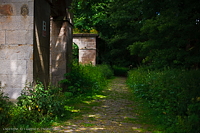 The
main 'spot' focus area is on the nearest left wall. This image was
processed in LR3 with very light contrast and saturation applied. I
finally used Canon's DPP Software to sharpen the LR3 re-sized web
'plate' image. The reason I use DPP is because I have no other software
for post processing sharpness........it does a great job for web images. The
main 'spot' focus area is on the nearest left wall. This image was
processed in LR3 with very light contrast and saturation applied. I
finally used Canon's DPP Software to sharpen the LR3 re-sized web
'plate' image. The reason I use DPP is because I have no other software
for post processing sharpness........it does a great job for web images.
Canon 24mm f1.4 L Lens
This lens is probably slightly too wide and I find it's use is limited for the majority of my photography. I think
that a Canon 35mm f1.4 L Lens could replace both the 24L and the 50mm
Lens in the bag. However, when the 24L is required, it delivers an
excellent image on the Canon 5D DSLR and the 'full frame' sensor really
makes good use of the lens quality. It has a terrible fitting hood which
is very tight on the lens. When fitting and removing I must remember to
use the flange edges of the hood (like your fingers acting as a
screwdriver) because if you distort the hood by gripping the round part
it will be difficult to fit on and take off. When I reverse fit the hood
on the lens, I hardly make any turn and in this way it is easier to take
off.
This MK1 is no longer made and has been replaced
by the MK2 model which delivers better CA control at wider apertures. In
its day the Mk1 was purchased for slightly under £1,000 and the
replacement model is now a great deal higher in cost. The 24L MK1 is a
heavy piece of glass but its quite short in the barrel when the hood is
not fitted. I did find that this lens was a weight around my neck with
the Canon 5D and put a strain on my neck and shoulders when it hung there for a
prolonged period. I found it easier to alternate carrying it between my
hand and around my neck or both. Unless used for a specific subject, this lens is more
than likely going to reside in my bag or left at home.
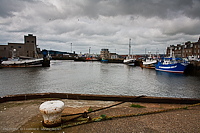 Its
a lens I would never sell, for it has its uses and the cost to replace
it with the MK2 version is just not worth it.........for me. Its
a lens I would never sell, for it has its uses and the cost to replace
it with the MK2 version is just not worth it.........for me.
When I was up at Peterhead in Scotland, the weather (on the day I
visited the harbour) was atrocious but I think the Canon 24L Lens caught
the flavour? I used it for a couple of wide shots but I must admit it
was the 100mm that I had the most enjoyment with.
This shot of the capstan and the harbour was processed in LR3 and extra
contrast and saturation were slightly applied. The settings were
ISO:100, aperture f8 and the shutter was 1/320sec. The depth of field
starts at the capstan and through to infinity..........it is not that
clear on the larger image due to the wideness of the capture but it is
in focus.
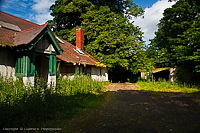 This
is a shot of the ruined farmhouse on the Cammo Estate using the 24L with
its hood on.
It was processed in LR3 and extra contrast and saturation were slightly
applied. The settings were ISO:100, aperture f8 and the shutter was
1/250sec. The depth of field in this shot was excellent at f8 and
covered the focus all the way through to infinity. This
is a shot of the ruined farmhouse on the Cammo Estate using the 24L with
its hood on.
It was processed in LR3 and extra contrast and saturation were slightly
applied. The settings were ISO:100, aperture f8 and the shutter was
1/250sec. The depth of field in this shot was excellent at f8 and
covered the focus all the way through to infinity.
For a wide lens, I am constantly surprised at just how much resolution
is delivered with the 24L on the 5D camera. In the harbour 'capstan'
image, the distant seagulls can be clearly seen and on the 'full size'
RAW image the clarity of distant objects is quite amazing. I am not
surprised that the replacement version MK2 is so expensive. I had used
this MK1 lens for a couple of years on my Canon 450D DSLR which
delivered a 38mm field of view with the 1.6x crop sensor and I had
thought the image quality was outstanding but it paled in comparison to
the IQ from the Canon 5D 'Full Frame' sensor camera.
These two images are perhaps not the best examples of what this Canon
24mm f1.4 L lens can achieve but the mood of the day is caught, even
although the harbour shot may not be to everyone's taste.
In Conclusion - 8th November 2011
I thoroughly enjoyed returning to my Canon 5D DSLR with it's 35mm 'Full
Frame' Sensor and using Canon Primes lenses...........in particular the
Canon 100mm f2 USM Lens, which I loved shooting wide open at aperture
f2.
Can I stand the size and weight of the kit or should I return to using
the Canon 450D? Actually I can because apart from the weight of
the Canon 5D and the Canon 24L Lens hanging around my neck during a
prolonged period, I did not find anything else a problem. Sure the
shoulder bag is larger than I would have liked and slightly heavier than
most other shoulder bags but I was never worried about bashing my camera
and lenses and it did not drag me down when I was carrying it.
I must admit that the primes on the 5D were a lot of fun, even my rarely
used 24L Lens which I found just a little bit to wide on the 35mm 'full
frame' sensor camera. It's field of view of 38mm on my Canon 450D had
been more to my liking and I had used it regularly on that camera. Did I
miss my Canon 24-105mm f4 IS L Zoom Lens or my Canon 70-200 f2.8 IS L
Zoom Lens..........of course I did for some of those shots that only a
zoom would have caught........but then primes are different, smaller,
lighter, great image quality and they make you work at your
photography............most enjoyable and a great diversion from zooms!
Can I
find digital 35mm 'full frame' sensor technology and lenses that are
smaller? Not at this time if I want autofocus and the flexibility of
zooms and prime lenses.
It will be interesting to see what Canon brings out
in
2012 and perhaps a smaller and 'leaner controlled' DSLR camera with a 35mm 'full frame' sensor will appear.
Since writing this article, I
discovered and
started to use the Lowepro 160 Rezo AW shoulder bag, which is even
smaller, lighter and takes my Canon 5D DSLR the Canon 100mm f2 USM Lens
and the Canon 50mm f1.4 Lens with spare battery, 58mm graduated 2 stop
filter and spare memory card.
If you have enjoyed this article - please donate to my
Charity of Choice -
The Sick Kids
Richard Lawrence
Scotland
United Kingdom
Back to Articles Page |











